Body length: 6–13 mm.
Eyes: eye interommatidial setaeseta:
a sclerotized hair-like projection of the cuticle
absent, eye deeply emarginateemarginate:
notched at the margin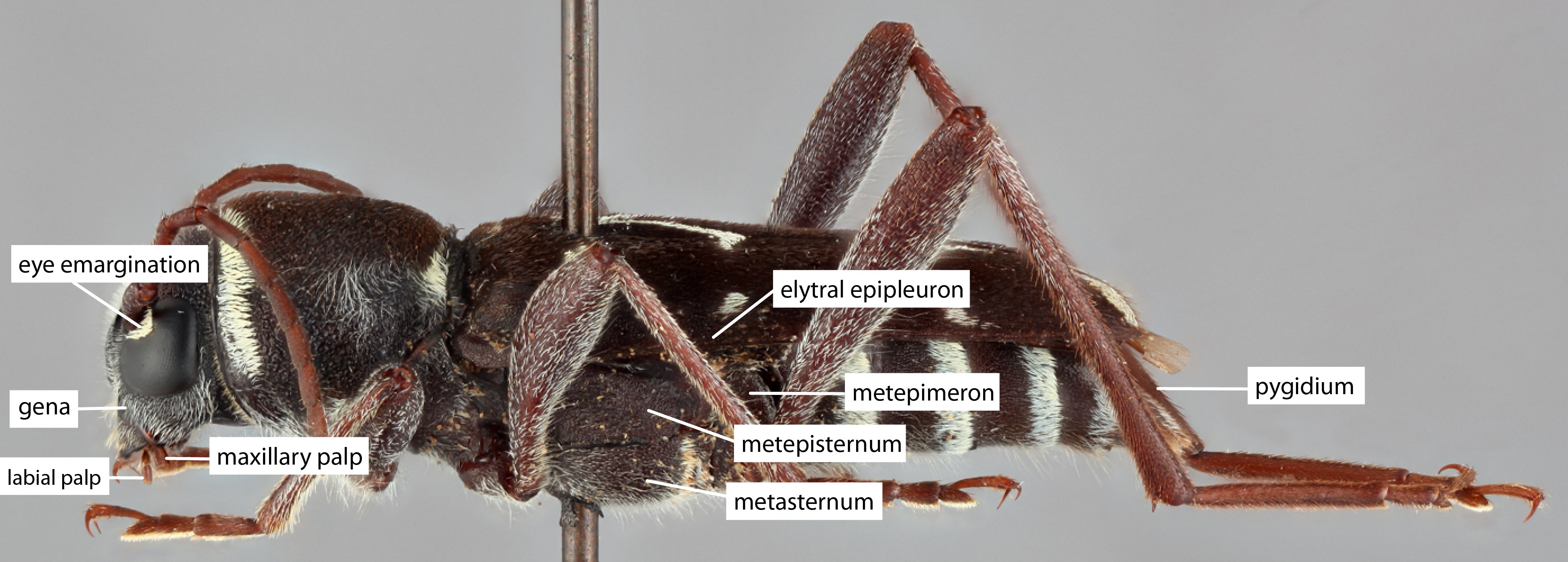 > half width, eye ommatidial density coarse.
> half width, eye ommatidial density coarse.
Antennaeantenna:
in larval and adult insects, paired segmented appendages, borne one on each side of the head, functioning as sense organs and bearing a large number of sensilla
: antennal length reaching/surpassing end of body, antennal flagellar segments elongateelongate:
much longer than wide
, scapescape:
the first proximal segment of the antenna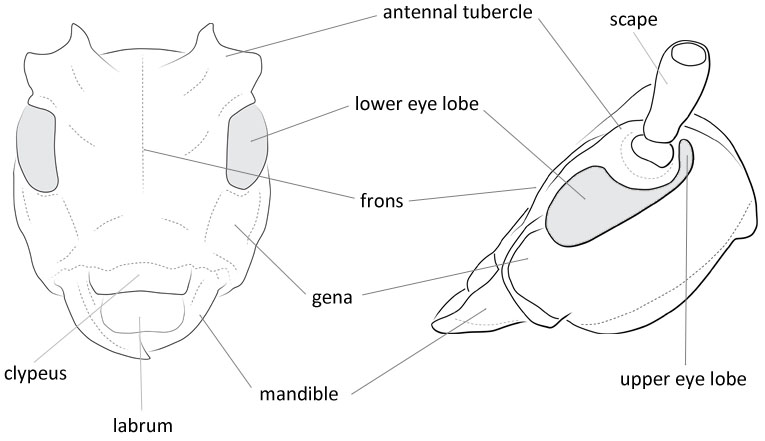 smooth/punctate at apexapex:
smooth/punctate at apexapex:
end of any structure distad to the base
, antennal scapescape:
the first proximal segment of the antenna ≥ segment 3.
≥ segment 3.
Pronotumpronotum:
the upper and dorsal part of the prothorax
: pronotumpronotum:
the upper and dorsal part of the prothorax
shape transversetransverse:
broader than long
, pronotumpronotum:
the upper and dorsal part of the prothorax
lateral armature acute spinespine:
a protuberance with an acute (sharp) distal end
.
Prosternum: prosternal processprosternal process:
a posterior extension of the prosternum between the coxae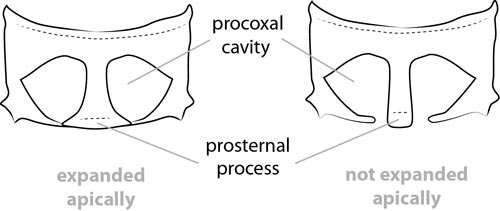 dilated at apexapex:
dilated at apexapex:
end of any structure distad to the base
, procoxal cavities closed posteriorly.
Elytraelytron:
the leathery forewing of beetles, serving as a covering for the hind wings, commonly meeting opposite elytron in a straight line down the middle of the dorsum in repose
: elytral length reaching or close to end of abdomen, elytral apicesapex:
end of any structure distad to the base
rounded or truncatetruncate:
cut off squarely at the tip
, emarginateemarginate:
notched at the margin or with tooth or spinespine:
or with tooth or spinespine:
a protuberance with an acute (sharp) distal end
, elytral color pattern present.
Legs: visible tarsomerestarsomere:
subdivision or article of the tarsus, usually numbering from two to five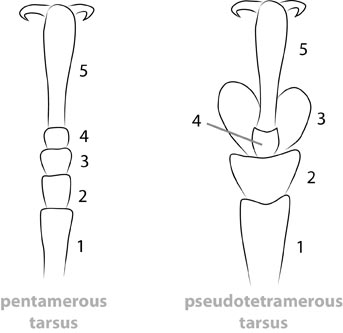 : 4, femora clavateclavate:
: 4, femora clavateclavate:
thickening gradually toward the tip
, protibial spursprotibial spur:
sclerotized spine(s) located at the distal tibia; can be single, double, or absent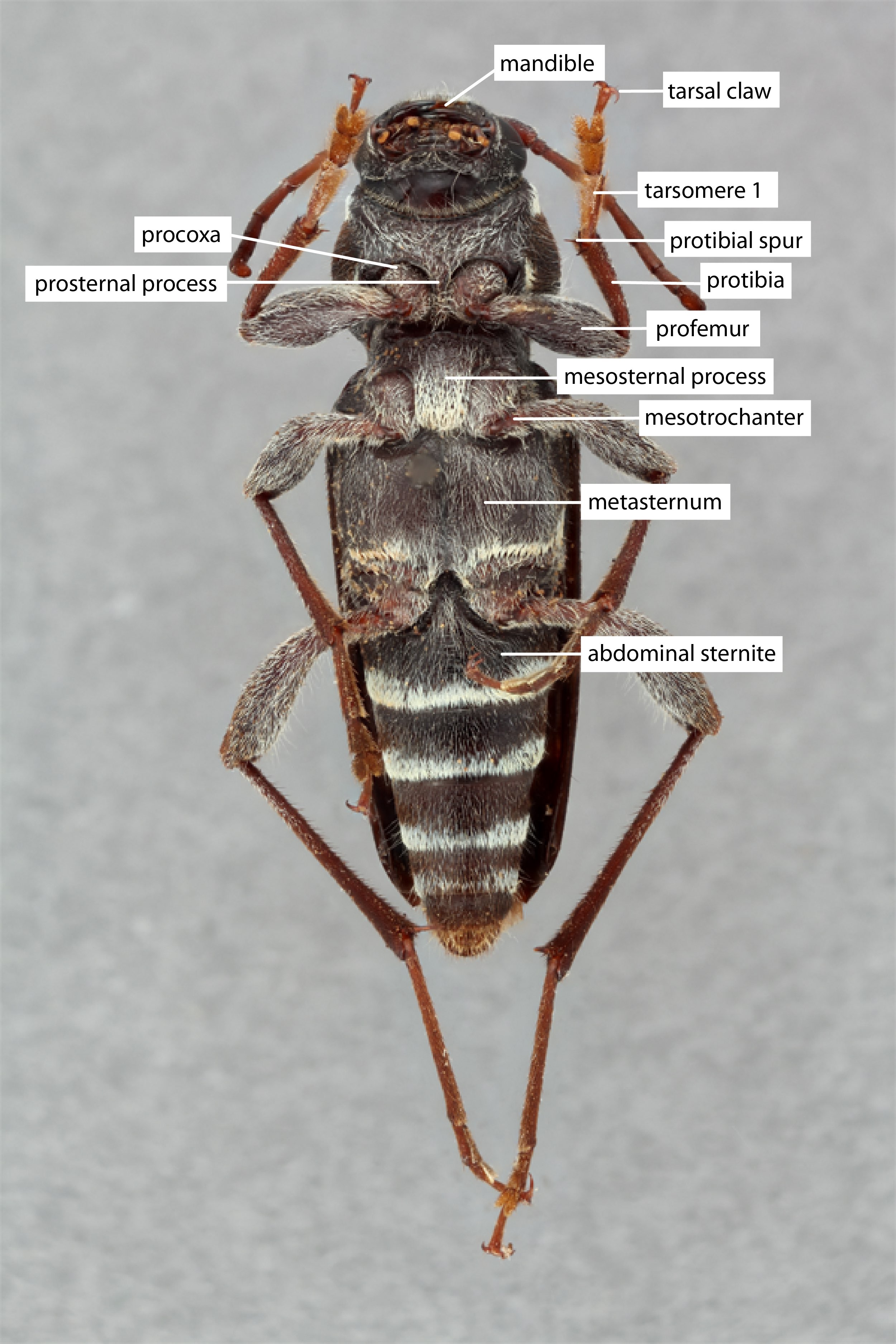 : 2, tarsal clawstarsal claw:
: 2, tarsal clawstarsal claw:
usually paired claws of the pretarsus, at the distal end of the leg simple.
simple.
Very elongated. Antennaeantenna:
in larval and adult insects, paired segmented appendages, borne one on each side of the head, functioning as sense organs and bearing a large number of sensilla
slender, sparsely fringed below with short hairs; the scapescape:
the first proximal segment of the antenna rather long and slender, the third segment shorter than the fourth, as long or shorter than the scapescape:
rather long and slender, the third segment shorter than the fourth, as long or shorter than the scapescape:
the first proximal segment of the antenna . Antennal tubercles distant and not very prominent. Eyes rather coarsely faceted and strongly indented. Transversetransverse:
. Antennal tubercles distant and not very prominent. Eyes rather coarsely faceted and strongly indented. Transversetransverse:
broader than long
pronotum, with four fine transversetransverse:
broader than long
furrows, two anterior and two posterior, and a lateral spinespine:
a protuberance with an acute (sharp) distal end
. Elytraelytron:
the leathery forewing of beetles, serving as a covering for the hind wings, commonly meeting opposite elytron in a straight line down the middle of the dorsum in repose
elongated, noticeably wider than the pronotumpronotum:
the upper and dorsal part of the prothorax
at its greatest width, sometimes furnished with erect hairs, the punctures sometimes aligned in the sutural third. Non-retractable head. Narrow prosternal projection, lower than the coxae, arched. Mesosternal prominence provided with a tubercletubercle:
a small knoblike or rounded protuberance
. Metasternum of normal length. Intermediate coxal cavities open. Medium length legs; weakly clavateclavate:
thickening gradually toward the tip
femurs; notched intermediate tibiaetibia:
the leg segment distal to the femur, proximal to the tarsus
(Breuning 1959Breuning 1959:
Breuning S. 1959. Révision des Acanthocini de l'Afrique noire (Troisième partie). Bulletin de l'Institut Français d'Afrique Noire, Dakar, 21, série A (2): 607–652, fig. 20.).
Neodiadelia, Mimectatina
A rather morphologically diverse endemic African genus. The antennaeantenna:
in larval and adult insects, paired segmented appendages, borne one on each side of the head, functioning as sense organs and bearing a large number of sensilla
fringed with setaeseta:
a sclerotized hair-like projection of the cuticle
below, open mesocoxal cavities, and lateral pronotal spines will help to diagnose this genus.
Afrotropical (most in Madagascar)
broadleaf trees
96 species in subgenus Diadelia; Adiadelia 2 spp.; Anadiadelia 1 sp.; Congodiadelia 1 sp.; Guineodiadelia 1 sp.; Myodiadela 7 spp.; Setodiadelia 5 spp.
Alophia Fairmaire, 1896
Paradera Aurivillius, 1915
Diadelia Waterhouse, 1882